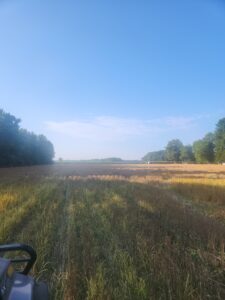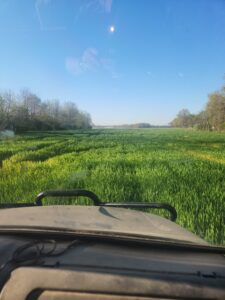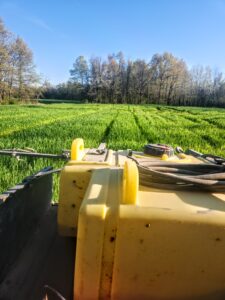Final report for FNC22-1324
Project Information
Stephanie Duncan: I have been worm farming since 2018. In 2020 we started Duncan's worm farm. Mark and I have a small scale business. We started selling worm tea the summer of 2021. We have approximately 50-60 thousand composting red worms. We collect used card board and use as bedding for our worm beds.
Farmers Jason Mann and Stephanie Duncan propose to collaborate to examine the benefits of worm tea in a field crop agricultural setting. In order to accomplish this goal, Mr. Mann will dedicate 1.5 acres of corn/wheat/soybean rotation ground. Ms. Duncan will produce worm tea in a concentrated form. Mr. Mann will apply the tea preplanting and at planting in a strip trial with two strips of treatment and one strip of control. The crop will be assessed throughout the growing season for plant nutrient content with soils being testing after harvest. The second-year treatments will be conducted similarly. Approximately one-half of the plot is disturbed soil needing remediation, while the other half is medium-to-high productivity soil. In this manner, we can assess worm tea as a crop nutrient across very different soils. Although worm tea is currently an expensive fertilizer, success with this experiment may allow for some utility bringing poor soils organic matter and a quicker return to economic viability. The substitution of synthetic commercial fertilizers for worm tea may be an ecologically sounds and socially responsible choice for some areas where economies of scale can develop.
- Assess the value of worm tea in large-scale agricultural farm management.
- Evaluate plant and soil chemistry and biology in two soil types under traditional and worm tea amended management.
- Explore the economic viability of worm tea in certain agronomic situations.
Cooperators
- - Technical Advisor (Educator)
- - Technical Advisor (Educator)
Research
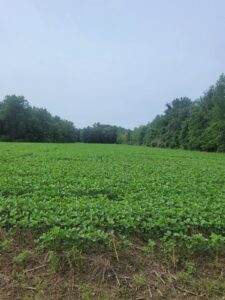
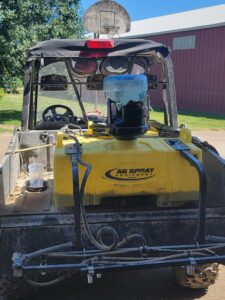
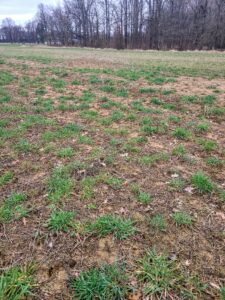
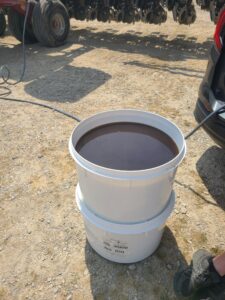
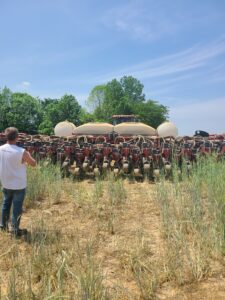
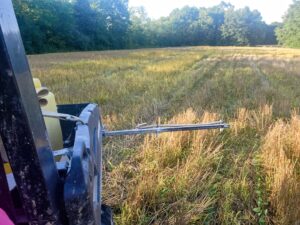
Saturday March 19,2022
We met Jason Mann and Hans Schmitz at the project site at 11 AM. Jason pointed out the condition of the field. We discussed which zones we would be treating with worm tea. There is a fescue currently planted as a cover crop. I did not want Jason to use a herbicide to kill off the cover crop. After discussing with Hans we decided Jason would till crop
under since it was time to level the field up some.
Jason provided us with some previous soil sample results to have a reference for our project. We will be marking off the field into treatment sections after Jason tills the field. Jason will have the soil sampling done at that time as well. Once the soil sample is taken we will apply worm tea. I took a few pictures of the field , the pictures show the trouble areas where soil quality is poor.
Sunday May 08, 2022, Initial spraying of worm tea extract
We loaded 60 gallons of water, 2, 15 gallon tubs, Transfer pump, 4 worm tea bags with 10 cups of Worm castings each bag, Organic Liquid Humic Acid , Hydrolyzed Fish and Seaweed Blend.
Met with Jason Mann (farmer) at the field site at 4 pm. Jason had a 45 gallon 7 nozzle boom sprayer on a Side by Side ATV. The Sprayer was set up with fine tip sprayer nozzles.
We used a transfer pump to fill a 15 gallon tub with water (well water). I massaged worm casting tea bags until most of the castings had liquified, then added ¼ cup of hydrolyzed fish and seaweed blend and ¼ cup liquid humic acid. The first Tea Bag did not seal well enough and some larger sized casting and Worm cocoons got into the tub. We use the transfer pump to pump worm casting extract directly into the sprayer. Mark held a painter's Strainer bag over the sprayers’ fill whole to catch any larger particles possibly left in the Tea extract. We repeated this process 3 times until the Sprayer tank had approximately 35 gallons in it.
We had Jason remove all inline nozzle filters as well as the tank filter. We tested flow rate prior to entering the field, and the flow was good. Jason was able to spray approximately ⅓ of the field when the 2 outer sprayers became clogged. We were able to remove debris with a nozzle probe. However it continued to clog. We then determined the fine mist nozzle was too small. We pumped out the sprayer and cleaned the tank with clean water. Jason replaced the sprayer nozzle tips with larger tip openings. He finished spraying the field with little trouble. We then discussed how we could improve the process for future sprays.
We decided that we needed to replace the heavy duty garden hoses used for the transfer pump. Jason was going to get a braided hose to prevent the hose from collapsing. I ordered a 5.7 inch by 7 inch pool strainer basket to use as a filter holder to insert in sprayers fill whole while loading tea extract. We are hoping this will speed up the fill process as well as free up a person from holding the bag while filling the tank. We also will be mindful to not suck the larger silt from the bottom of the mixture while filling the sprayer tank.
Jason is planning on planting the field later this week pending weather. We will be using tea extract in furrow while planting corn. We were at the field for approximately 2 hours.
May 14th, 2022
We met Jason Mann (farmer) at his farm shop on May 14th, 2022. We brought a 60 gallon tank of well water, 2 20 gallon tubs for mixing worm extract in. We used 20 cups of worm castings and 1 cup of each liquid humic acid and hydrolyzed fish and seaweed blend.
We made approximately 50 gallons of Worm tea. We connected a transfer pump to load directly to the planters’ tank. The planter had two 275 gallon tanks on it however we only used one side. We loaded 50 gallons of Worm tea into the planters’ tank. We changed out the sprayer nozzles to a 70 orifice , there were no inline filters, only a pump filter. Jason set the flow rate to 15 GPA at 25 psi. We headed over to the field site. Hans Schmitz met us at the field site. Jason primed the pump then made a pass around the field to set the tractor's GPS. After the tractor was programmed Jason lined the tractor up to the middle section of the test plot which would be planted with worm tea in-furrow. We had to change a couple of the sprayer nozzles that were not working properly. Once the planter was operating properly he planted the center section in-furrow. The 2 outside swipes were not planted in-furrow as the control .
The whole process from setup to finish was about 2 .5 hours due to some technical difficulties.
There was approximately 20 gallons of tea left after planting was completed. Jason drained remaining tea into his ATV sprayer and sprayed it over the center test section that evening. Jason cleaned the planter tank and spray lines with bleach water as well as the ATV sprayer.
Jason reported that corn was up 5 -6 days after planting. We had a good stand.
June 18th, 2022 Last application of worm tea
We brewed 45 gallons of Worm Tea , We used 20 cups of worm castings, 1 cup humic acid and 1 cup of seaweed/hydrolyzed fish blend in 45 gallons of unchlorinated water. Aerated mixture for 24 hours in a 60 gallon water tank. We delivered tea to Jason (farmer), he loaded it in a 45 gallon ag sprayer which was on back of his side by side ATV vehicle with a 7 nozzle boom. Jason applied 45 gallons of worm to the standing 40 foot strip of our test plot.
September 24th, 2022 Harvested Field
Harvest was made difficult by weed pressure due to lack of in-season weed control. Fall panicum in particular was a problem weed.
250 lbs P& 200 lbs K applications were made post-harvest around wheat planting.
October 14th, 2022 Winter Wheat Planted
Vertical tillage was used immediately prior and post broadcast wheat planting.
January 7, 2023 Winter Meeting between advisors and farmers
March 20th, 2023
We Met with the Farmer Jason Mann and Advisor Hans Schmitz Monday evening 5: 30 at Zap’s. Jason reported that the Winter Wheat was looking very good and is very pleased with its stance at this point. We went over the grant timeline for 2023. Plant tissue testing to be ordered for April on the winter wheat. Stephanie will call the Farm Bureau in Mount Vernon Indiana to schedule. Jason(Farmer) will be applying Harmony herbicide between the last week in March and the 1st week in April. Stephanie contacted Troy Hinke Chief Biologist, Urban Worm Company to ask when we should apply worm tea, before or after application of Harmony Herbicide. Troy said it is best to apply anything with beneficial biology after applying herbicide, he suggested a few days later would be fine. Jason will let Stephanie know when he applies Harmony and schedule to Spray Wheat with Worm tea a few days to a week following spraying of Harmony Herbicide. Jason(farmer) will call and order soil microbial testing to be done mid June. We will be using the same company as last year. Jason will start harvesting wheat around June 15th. We will plan another application of Tea at the time of planting soybeans. Stephanie will order a plant tissue test of soybeans in August with the Farm bureau of Mount Vernon. Hans Schmitz, Advisor Purdue Extension, will coordinate with a Drone operator to Spray the Soybeans Late August. Hans will schedule our Farmer Field day the same day and possibly hold the event at Alexandria Library. We discussed trying an inline screen filter to be used when loading Tea into a sprayer to try and avoid clogging sprayer nozzles with worm cocoons. Mark will pick one up at the Farm supply store later this week to try it out. Jason will start harvesting Soybeans in November.
April 12, 2023
April 11th,2023- Started Worm Tea 4 pm. Filled four 15 gallon totes 45 gallons with unchlorinated water.
I added 1⁄2 cup of Fish emulsion, 1⁄2 cup of humic acid circulated with an air pump. I then filled 4 tea bags with 5 cups of worm casting each then inserted one into each tote. Tea was aerated for 24 hours. April 12th we used a Milwaukee pump with 3 screen filters attached to triple screen tea to prevent worm cocoon shells from clogging sprayer nozzles. We transferred brewed tea into a 60 gallon water tank. We met Jason Mann (Farmer) at the field site. We used the Milwaukee transfer pump to fill the ATV Sprayer. This process took less than 8 minutes to transfer 45 gallons of tea to the sprayer. Jason sprayed the center test plot of winter wheat with all 45 gallons at a rate of 175 GPA. We decided to apply heavily due to the poor conditions of the field's soil. The normal application would be 5 gallons per acre. It took approximately 30 minutes to spray on all 45 gallons. When finished we filled the sprayer with fresh water and a half cup of bleach using the transfer pump. We cleaned out any leftover residue of worm tea to prevent any biofilm from sticking to tanks , hoses and the transfer pump. The whole process of loading, spraying and the clean up took less than an hour. It went much smoother this year. No clogged sprayer nozzles. Jason is going to order soil to be sampled after winter wheat is harvested.
Meeting adjourned 7:30pm
June 23. 2023 Harvested Winter wheat
June 28,2023 Planted Soybeans.
July 12, 2023 Sprayed Soybeans
We met Jason Mann at the test field around 6:30 at night. Loaded 15 gallons of worm tea into his ATV Sprayer. We used a Milwaukee transfer pump with 2 inline screen filters in place. We applied the tea to the center test strip at a rate of 50 gallons an acre. It took approximately 20 minutes to load and spray the field. The Soybeans have a good stance with no dead spots on the entire test field. We used same processes as previously stated to load sprayer and then clean sprayers. No problems occurred.
August 7th, 2023 meeting to go over Field day presentation.
We had a short meeting to go over materials to be presented at the upcoming Field day. It was decided Stephanie would be giving the presentation and farmer Jason Mann would answer any questions brought up by the any of the participants. Hans Schmitz coordinated the event to coincide with upcoming PARP credit event for local farmers sponsored by Nutrient and Purdue Extension on 08/25/2023. Lunch would be provided at this event. It was to held at the Posey County Community Center in New Harmony Indiana.
August 25th, 20203 Field Day
The Field event started at Noon with a catered meal. Then Hans Schmitz, Purdue Extension Coordinator, started the program by going over some upcoming events and introduced Speaker Eric Snodgrass, Nutrien representative. Eric Snodgrass gave presentation on Weather Recap W/Nutrient and pesticide considerations in a drought. I then gave our presentation. I had a slide presentation with information we had obtained during our Grant research, I included pictures of the field and sprayer used. We discussed how worm tea could benefit and be used in large scale farming. Jason fielded a few questions from attendees. We felt like we had a very good turn out, approximately 65 farmers attended the presentation. We felt combination of the 2 events was not only price effective but time effective. Farmers are busy making it hard to attend Field day presentation. By combining the 2 speakers we were able to get to a larger crowd. Win win.
October 25, 2023 Harvested Soybeans
Jason Mann harvested the soybeans on 10/25/23. He stated that the area of field that we had been treating with worm tea had a slight increase in yield and did not have any blank spots. He said this was the first time since it starting managing the field that it did not have dead spots. The field produced 36 Bushel per acre.
BeCrop Fall 2365102 River Bend Ag - CBW01O_TM-TEST
projects.sare.org/…/65102-River-Bend-Ag-CBW01O_TM-TEST.pdf
Corn yield in the treated plot was 11 bu/acre. Corn yield outside the treated plot was 37 bu/acre. The lack of yield in the treatment was due mostly to sun exposure allowing weeds to thrive more so than in the partially shaded control. Drought and flooding also played a role in the low corn yields in 2022, particularly wet weather during stand establishment. The rest of the adjacent field averaged 138 bu/acre. Winter wheat was planted on October 14, 2022, with a meeting to alter weed control methods held in early 2023.
Wheat harvested on June 23/2023
No dead areas in the entire field. The treated area yielded 32.8 bu/ac. The adjacent field yielded 55.5 bu/acre. This was considered a big improvement.
Soybeans harvested on October 23,2023. The treated area yielded 17.3 bu/ac and the adjacent pass untreated field yielded 28.9 bu/ac.
"This is all good considering 5 years ago the treated area yielded zero bu/ac, " Farmer Jason Mann
Megan Gilpatirick, Certified Soil Food Web Technician.
Educational & Outreach Activities
Participation Summary:
February 12, 2022
Spoke about grant and benefits of vermicomposting at Lincoln State Park Soil and Water Conservation District (SWCD) . We had approximately 25 attendees. We had a slide presentation and discussed vermicomposting and its benefits for small and large farming. The event was advertised Via SWCD web page and Facebook page.
July 14, 2022
We spoke at Reimann's Farm about the benefits of vermicompost teas and extracts. This was sponsored by Push-IT - promoting Urban Soil Health in Towns. We had approximately 10 attendees.
February 11, 2023
Presented the research we were working on with NCR-SARE grant. The event was sponsored by Spencer County Soil and Water Conservation district (SWCD) and was advertised via internet and Facebook. We had approximately 25 attendees.
March 23, 2023
Spoke at Lyles Station to Indiana agriculture and technology School students about vermicomposting and how we are using teas in large scale farming. We spoke about ways if can help environment and provide and income.
May 30th, 2023
Gave a presentation on our grant project to the Southwestern Indiana network- Sierra Club. There were approximately 15 attendees. The event was advertised via SWIN Sierra club network and Facebook.
August 25, 2023 Field Day
We held the Event at the Posey County Fair Grounds. We decided to collaborate with parp-by-nparp-by-nutrien-purdue-extension (1)utrien-purdue-extension. We felt it would be a good way to get more local farmers to take time out to hear about our research and there was a good turn out, approximately 65 attendees present. Since then we have a few more inquiries from farmers who attended that meeting about using vermicompost tea on their farms.
Learning Outcomes
2022
One of the biggest hurdles was finding a local source for testing soil, tea, and compost. I was unable find a laboratory to professionally test Worm Tea. Worm Tea should be tested within hours from when the brewing process is completed, so we were unable to mail in samples. I was able to view samples under a microscope at our farm. We ordered a complete microbial soil test, soil samples were taken prior to planting. It took over 10 weeks to get results.
When we tried to spray the field the 1st time we clogged up the sprayer nozzles. We needed to remove all inline filters and make sure we had a larger spray nozzle on. Before loading the tea into the sprayer make sure to use a finer filter.
Weed control cannot be overemphasized. Despite potential disruption in biological activity, chemical weed control was needed. Weeds were the number one reduction in corn yield in 2022.
More preparation for precision guidance systems would have created greater ease of in-season application of worm tea.
2023
My name is Jason Mann and I’ve been a row crop farmer in So. Posey Co. since 1994. I met Stephanie and Mark Duncan in 2021 at another business of mine where we struck up a conversation about agriculture. This led to a conversation about their worm farm and they proceeded to tell me about the benefits of worm tea and all of its wonders. I was asked by Stephanie and Mark if I had a particular piece of ground that struggled with low production and a lack of microbial activity. I had the perfect acre to match that description and that is where the journey began. It was made clear from the beginning that my role in this study would be to help Stephanie and Mark apply their product on a larger scale than what they had been accustomed to and assist them in the application of the worm tea and also in monitoring the impacts of their product. Now that we’re nearing the end of this study it’s becoming clear that the worm tea definitely had a positive impact on this poor tract of farmland.
Some of the things we struggled with in the beginning were problems such as straining any unwanted material from their product to make it easier and less troublesome to apply and that was achieved by some discussion in one of our meetings where we came up with a filtering system to separate the unwanted material. This solution sped up the application time and gave us a much more uniform rate. Some of the concerns I had and still have is how to manage weeds. I haven’t seen enough data to be confident that this product is an effective weed management tool but it was only a 2 year study. Some things I saw that were undeniably beneficial was how the worm tea moved the needle in a positive direction on almost every single area on the soil DNA test that we took at the beginning and end of the study.
In summary, I truly feel there’s a fit for this product in modern agriculture but there are definitely some obstacles to overcome before it’s realistic on a large scale but that is the point for studies like this. In a farming world full of chemicals and synthetic fertilizers I really feel there will be a growing need for self-sustainable products such as worm tea especially since we’re learning more daily about the harmfulness of some of the current products in use.
Project Outcomes
Recommend using traditional weed control methods despite potential disruption of biological activity, at least for initial research projects.
